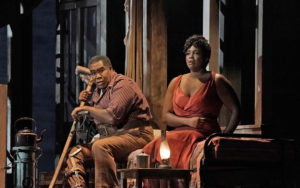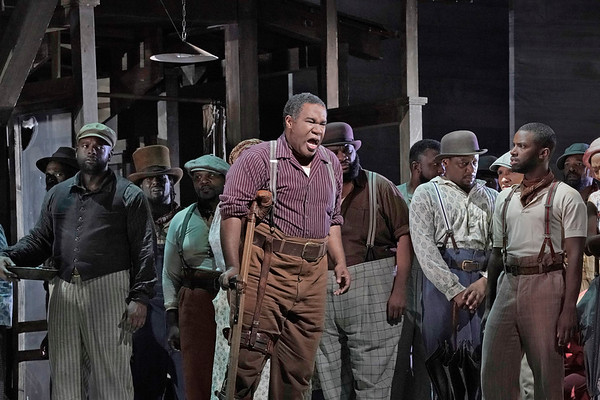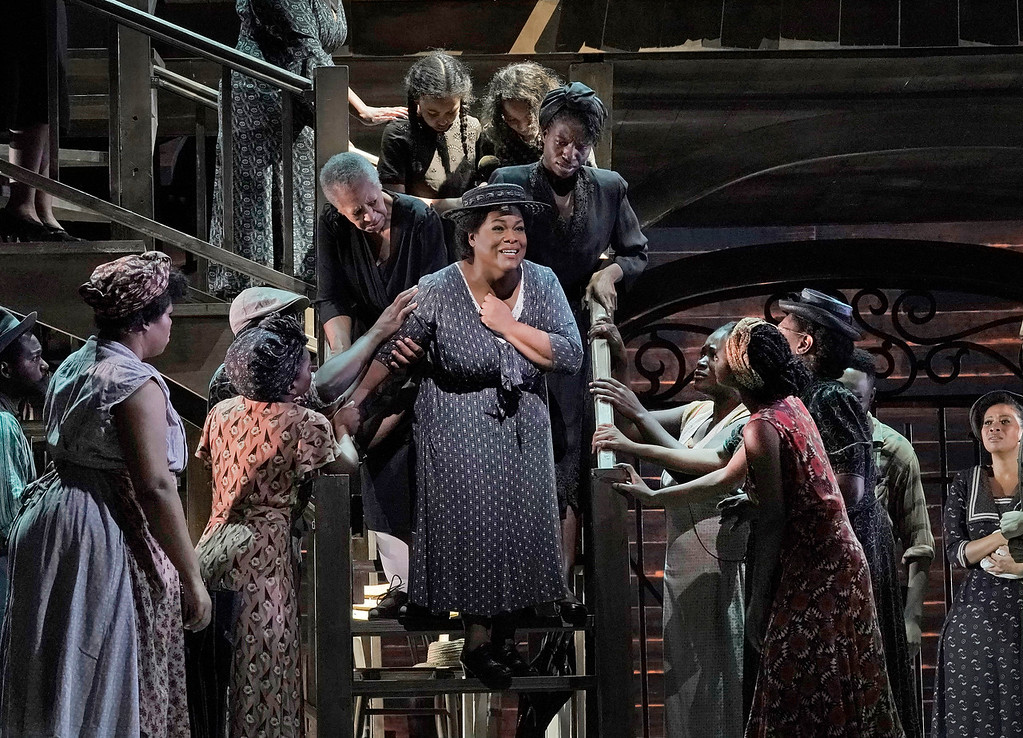
Metropolitan Opera 2019-20 Review: Porgy and Bess
Eric Owens, Latonia Moore, Angel Blue Lead A Fantastic Cast In Gershwin Classic On Opening Night
By David SalazarWhile the environment outside the Met Opera on opening night was rather subdued in comparison to previous years, there could be no denying the environment inside of the sold-out house. Everywhere you turned, the opera on hand was a major topic of conversation with great excitement over what it might bring.
The Gershwin classic, “Porgy and Bess,” hasn’t been at the Met in nearly 30 years, with the last set of showcases taking place in 1990. This performance marked just the 55th in the company’s history since it first premiered here in 1985. So there could be no denying that there was great anticipation for what a new “Porgy and Bess” could bring, especially with a cast of superstars onstage.
And the show proved itself a triumph thanks to that very strong cast and a solid production, that despite some shortcomings, was elegant in its construction and told the story clearly.
Visually Appealing, Though Not Without Issue
As directed by James Robinson and designed by Michael Yeargan, this production of “Porgy and Bess” features a rotating set that presents the Catfish Row tenement as a series of two story buildings with a central hub around which the people gather. The set up allows for the environment to be constantly populated and feel alive with people. There are two prominent set changes throughout the evening for Kittiwah Island and Serena’s room during the storm. The brown that dominates the set is offset by the more colorful palette employed by the diverse costuming of the characters themselves, emphasizing their distinct natures amidst a rigid and harsh lifestyle.
As far as presentation goes, this production is probably everything a Met audience could ask for. It’s lively, colorful, literal, and features some strong choreography by Camille A. Brown throughout many choral numbers. There is also some fantastic fight choreography by David Leong when Crown murders Robbins and when Porgy eventually does the same to Crown.
But it isn’t without some shortcomings. The opera is portrayed in two acts, instead of three, which means that the first Act ends on Kittiwah Island, halfway through what is traditionally known as Act two. As such, the work ultimately starts to drag a bit with the first Act featuring four different curtain drops that break up the pacing of the evening. Instead of a “Brief Pause,” we hear atmospheric sounds to keep the audience “in the moment,” but the reality is that this simply lengthens what is already an expansive first half. The second half, which combines Acts two and three can’t help but feel a bit long as well as a result.
It doesn’t help that after a while, the visual appeal of the first half starts to feel redundant in the second. The choral numbers, which arguably slow the action to the halt, start to look the same with similar choreography centered around a static group. One feels that some of the choral pieces, particularly in Act two, could have been cut to keep the dramatic flow of the central story at the forefront without so many breaks in the action.
Robinson also makes some big choices with regards to Bess’ relationship with Crown and Sportin’ Life that prove to be shocking in the moment, though could arouse discussion over her character’s diminished agency. Crown doesn’t force her to stay on the island, but she instead seems turned on by his trying to force himself on her and stays with him. Additionally, Bess isn’t forced to take the “happy dust” by Sportin’ Life as suggested in the original libretto but here runs after it like an out-of-control junkie. In both cases, it seems like some inner part of Bess seizes control of her and forces her into those painful situations. In essence, one could argue that her actions and subsequent “fall” are self-inflicted and as portrayed, Bess is doing more harm to herself than the men themselves.

(Credit: Ken Howard / Metropolitan Opera)
Three Men
Those aspects aside, the production boasted a fantastic cast.
At the core of the story is Eric Owens’ Porgy, a broken man who gains strength as he finds what he believes to be true love, all of which was reflected in Owens’ vocal and physical interpretation of the role throughout the evening. His opening lines, “Evenin’ ladies, hello boys” features a softer, more granular vocal quality that hinted at his loneliness and broken nature. Owens’ voice retained this harshness throughout early instances though he would start to bloom with “I got plenty o’nuttin.” An ascension into a higher placement for the final reprise of the main melody sounded uncomfortable, but the final high note of the piece was gorgeous in not only how it sounded, but the crescendo he employed to bring it to a triumphant close.
Better still was the duet “Bess, You is my woman now,” where Owens’ voice really came into its own, the tone tender and delicate with glorious legato singing; he melded perfectly with Angel Blue’s similarly wholesome timbre. This is the emotional high point of the story of Porgy as from here, his resolve is repeatedly tested by Bess and Crown. And while Owens’ portrayed Porgy as a man of increased strength, there was never the least bit of violence in him. Even in his battle with Crown, Owens managed to make Porgy look like a man defending himself instead of an aggressor looking to harm anyone.
As such, his final scene proved heartbreaking with Owens’ imbuing the character with a combined wisdom and naiveté as he comes to terms with Bess’ choice. Here Owens’ voice was at its best, soaring in the upper range with a purity that had not been heard throughout the night. It was the textbook example of a singer growing throughout a performance to deliver his very best at the apex of the show.
Owens’ portrayal of Porgy as a broken man was cast perfectly opposite Alfred Walker’s Crown and Frederick Ballentine’s Sportin’ Life. As the two men vying for Bess throughout the story, they are moral opposites to Porgy in every way. Crown is a potent Alpha Male who solves everything with violence. Sportin’ Life is the polar opposite – a man who knows that to overcome his own physical limitations, he has to be cunning and smart.
Walker is an imposing figure with a similarly powerful voice that he wielded to violent effect. He walked about with a piercing glare that immediately injected every one of his scenes with tension. His famed “A red-headed woman” was sung with ferociousness, the bass-baritone pouring out his voice and enunciating the text with pointedness that made the misogynistic verses all the more uncomfortable to listen to.
Alternatively, Ballentine’s Sportin’ Life was the personification of a slippery rattlesnake, as Bess calls him in their final confrontation. Often placed on the extremes of the stage to emphasize his status as an outsider of the wholesome community, he would slide his way on stage with a charm and charisma that was visible nowhere else in the Met on Monday. He danced, he glided, and more importantly, he sang with a flexible tenor that moved from malleable and bright in “It Ain’t Necessarily So,” to harsh and virile in the final scene with Bess. While the climactic high note might have sounded a bit off in its placement during this final scene, the effect of a man sexually energized by having Bess under his control was spot on in its depiction.

(Credit: Ken Howard / Met Opera)
Three Women
As Bess, Angel Blue’s ample soprano took flight during her first entrance of “Oh the Train is at de Station,” where she managed a spectacular ornamentation to a high note. She was even better in the duet with Porgy, her voice at its purest and most delicate. She wove together magnificent legato lines that coalesced with Owens’ own to form one of the touchstone moments of the entire evening. She also delivered a glorious rendition of “Summertime” near the work’s climax, her voice tender and intimate.
There is also no questioning Blue’s commitment onstage throughout the night. Even in moments where she wasn’t singing, a quick glance in her direction would reveal the character fully engaged with the world. This was most potent during “My Man’s Gone Now,” where there was visible guilt on her visage as she sat off to one corner amidst the chorus.
Bess’ character is contrasted with those of Maria and Serena, both who live on without men in their lives. Serena loses Robbins in the opera’s first scene but manages to move forward, while Maria is portrayed as a the heart and soul of the community, the one moral constant that anyone can constantly turn to.
As Serena, Latonia Moore arguably stole the show with her “My Man’s Gone Now.” Descending stairs, Moore’s sound swelled into the large auditorium with increased intensity. You could sense all of the energy in the hall was moving in her direction and she continually built the aria to a rousing conclusion with a glorious glissando to her high range. She held the result high note for quite some time with the orchestral postlude overpowered by the audience’s tremendous enthusiasm. But she wasn’t done and she repeated the same vocal feat one last time, this time over the chorus, to show-stopping applause; it was the longest ovation on the night for arguably the most immersive and penetrating vocal moment of the entire evening.
After this moment, Serena fades a bit into the background of the story, though Moore’s intermittent appearances showcased a woman full of resourceful strength and optimism.
It matched up with Denyce Graves’ Maria, who was portrayed as the moral core of the story. While Graves’ mezzo sounds a bit battered and wobbles now, there can be no denying her fierce stage presence and the way that she dominates a scene with a simple shift of expression. This was best exemplified in her confrontation with Sportin’ Life, “I hates yo’ struttin’ style.” The passage, delivered in a parlando style that allowed Graves to added greater accentuation on her consonants, saw the mezzo overpower Sportin’ Life with simple intimidation; she had him cowering with a few steps in his direction, forcing him to run from her with every glare she threw his way.
And while she was harsh with the story’s lowlifes, she was gentle and tender with the characters she cared for. This was most noticeable in the trio “Oh Bess, Oh Where’s my Bess?” where her sound merged well with Owens and Moore; her rugged mezzo was a suitable counterpoint for Moore’s soaring soprano and Owens’ murkier tone.

(Credit: Ken Howard / Metropolitan Opera)
Stellar Casting All-Around
Every other character in the story plays his or her role, however small, in building up the world of the story.
As Jake and Clara, Ryan Speedo Green and Golda Schultz were a winsome couple. Schultz’s golden soprano radiated in “Summertime,” every phrase smoothly connected and a simply joy to luxuriate in. Her final reprisal was the polar opposite, the voice poured out its limits with accentuated phrases that expressed Clara’s sense of pain and loss. Green’s earthier timbre proved a fitting contrast, especially in his opening “A Woman Is a Sometime Thing,” where he imbued Jake with a playful cynicism as he rocked the tiny baby.
Other major standouts were Leah Hawkins as the Strawberry Woman and Chauncey Packer as the Crab Man. Both singers really delivered standout moments, the former blasted out some eye-opening high notes at the end of her phrase, while the latter delivering the biggest laughs of the entire night. Packer also managed a solid transition from playful to violent as Robbins.
Errin Duane Brook, Jamez McCorkle, Chanáe Curtis, Tichina Vaughn, Reginald Smith Jr., Jonathan Tuzo, and Arthur Woodley were all essential parts of the ensemble and deserved mention. The same goes for Mike Jenkins and Bobby Mittelstadt who portrayed the police officers, Grant Neale as the detective, and Michael Lewis as the coroner in scenes that undeniably added tension to the work for how they commented on modern events.
The chorus for the opera was simply otherworldly throughout the evening, as was the orchestra under the direction of David Robertson. The music had a forward-moving energy throughout, though there was a sense of metronomic rigidity throughout the performance. Nonetheless, Robertson managed to blend the orchestra well with the soloists, doubling their melodies in the solo numbers effectively. Moreover, the singers themselves were given greater interpretative bandwidth with some of the solo numbers as well.
On the whole, audiences will likely walk away thrilled at this new “Porgy and Bess,” the result of smart casting and a solid conception of a classic work.



